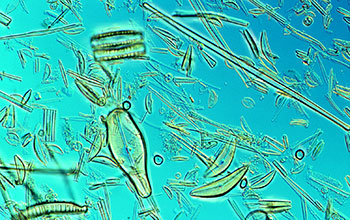Multimedia Gallery
Periphyton community of diatoms
This periphyton community was taken from Lake Khovsgol National Park in north-central Mongolia and contains hundreds of species of diatoms. [One of 7 related images. See Next Image.]
More about this Image
Mark B. Edlund of the University of Michigan is in the process of collecting, cataloging and preserving diatom specimens from a remote lake in north-central Mongolia. Microscopic algae are an important part of most aquatic habitats. They often live within narrow environmental conditions and can act as bioindicators for changes in pollution, water temperature, nutrient levels and salinity.
"Diatoms are incredibly valuable as a tool for water quality monitoring," Edlund explains. "And they are one of the primary tools used in paleoecology, a discipline that uses fossil organisms to decipher environmental history."
Edlund received a three-year postdoctoral U.S. National Science Foundation International Research Fellow award for his work on diatoms in Mongolia's Lake Khovsgol National Park. He and a collaboration of American and Mongolian scientists have made over 600 collections of diatoms to date from the lake and have established permanent herbarium collections at the National University of Mongolia and the California Academy of Sciences, the University of Michigan and the Science Museum of Minnesota.
Lake Khovsgol and the surrounding region was chosen because it is one of the most pristine large lakes on Earth and therefore globally significant as a natural laboratory for the study of ecology and evolution. The lake is estimated to be over 1.6 million years old.
[Research supported by NSF grant OISE 9802816.]
Credit: Mark B. Edlund, Ph.D.
See other images like this on your iPhone or iPad download NSF Science Zone on the Apple App Store.
Images and other media in the National Science Foundation Multimedia Gallery are available for use in print and electronic material by NSF employees, members of the media, university staff, teachers and the general public. All media in the gallery are intended for personal, educational and nonprofit/non-commercial use only.
Images credited to the National Science Foundation, a federal agency, are in the public domain. The images were created by employees of the United States Government as part of their official duties or prepared by contractors as "works for hire" for NSF. You may freely use NSF-credited images and, at your discretion, credit NSF with a "Courtesy: National Science Foundation" notation.
Additional information about general usage can be found in Conditions.
Also Available:
Download the high-resolution TIFF version of the image. (5.2 MB)
Use your mouse to right-click (Mac users may need to Ctrl-click) the link above and choose the option that will save the file or target to your computer.

 All images in this series
All images in this series